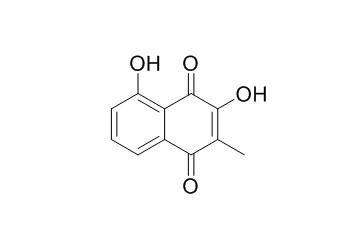Droserone
Droserone exerts an antifungal effect on a wide range of plant and human fungal pathogens. Droserone inhibits in vitro measles virus infection.
Inquire / Order:
manager@chemfaces.com
Technical Inquiries:
service@chemfaces.com
Tel:
+86-27-84237783
Fax:
+86-27-84254680
Address:
1 Building, No. 83, CheCheng Rd., Wuhan Economic and Technological Development Zone, Wuhan, Hubei 430056, PRC
Providing storage is as stated on the product vial and the vial is kept tightly sealed, the product can be stored for up to
24 months(2-8C).
Wherever possible, you should prepare and use solutions on the same day. However, if you need to make up stock solutions in advance, we recommend that you store the solution as aliquots in tightly sealed vials at -20C. Generally, these will be useable for up to two weeks. Before use, and prior to opening the vial we recommend that you allow your product to equilibrate to room temperature for at least 1 hour.
Need more advice on solubility, usage and handling? Please email to: service@chemfaces.com
The packaging of the product may have turned upside down during transportation, resulting in the natural compounds adhering to the neck or cap of the vial. take the vial out of its packaging and gently shake to let the compounds fall to the bottom of the vial. for liquid products, centrifuge at 200-500 RPM to gather the liquid at the bottom of the vial. try to avoid loss or contamination during handling.
Nutrients.2022, 14(19):4170.
Molecules.2019, 24(2):E343
Molecules 2022, 27(3),960.
Drug Des Devel Ther.2020, 14:5189-5204.
Molecules.2019, 24(1):E159
Asian Pac J Cancer Prev. 2020, 21(4):935-941.
Progress In Microbes & Molecular Biology2025, 8,1:a0000470.
Pharmaceuticals (Basel).2021, 14(8):742.
Plants (Basel).2023, 12(6):1259.
Chinese Medicine2019, 14(1)
Related and Featured Products
Planta Med. 2017 Feb;83(3-04):232-238.
The Plant-Derived Naphthoquinone Droserone Inhibits In Vitro Measles Virus Infection.[Pubmed:
27420351 ]
The naphthoquinone Droserone (1) is a natural product occurring in dicotyledonous plants.
METHODS AND RESULTS:
We have now observed that the addition of 1 during infection of tissue culture cells with measles virus considerably reduced the infection. Interestingly, the infection was inhibited only when Droserone (1) was added during virus entry, but not when added to the cells prior to virus uptake or after virus uptake. These findings suggest that 1 interacts with viral particles to reduce infectivity. The formation of progeny measles virus particles was inhibited to 50 % by Droserone (1) at a concentration (IC50) of approximately 2 μM with a half-maximal cytotoxicity (CC50) of about 60 μM for Vero cells. Other tested naphthoquinone derivatives, among them the likewise natural plumbagin (2), but also synthetic analogs, were either more cytotoxic or not as effective as 1.
CONCLUSIONS:
Thus, our data do not support the development of naphthoquinone derivatives into antiviral compounds, but suggest that they may be interesting research tools to study measles virus entry into cells.
J Exp Bot. 2010 Mar;61(3):911-22.
Induced production of antifungal naphthoquinones in the pitchers of the carnivorous plant Nepenthes khasiana.[Pubmed:
20018905]
Nepenthes spp. are carnivorous plants that have developed insect capturing traps, evolved by specific modification of the leaf tips, and are able to utilize insect degradation products as nutritional precursors. A chitin-induced antifungal ability, based on the production and secretion to the trap liquid of Droserone and 5-O-methylDroserone, is described here.
METHODS AND RESULTS:
Such specific secretion uniquely occurred when chitin injection was used as the eliciting agent and probably reflects a certain kind of defence mechanism that has been evolved for protecting the carnivory-based provision of nutritional precursors. The pitcher liquid containing Droserone and 5-O-methylDroserone at 3:1 or 4:1 molar ratio, as well as the purified naphthoquinones, exerted an antifungal effect on a wide range of plant and human fungal pathogens. When tested against Candida and Aspergillus spp., the concentrations required for achieving inhibitory and fungicidal effects were significantly lower than those causing cytotoxicity in cells of the human embryonic kidney cell line, 293T.
CONCLUSIONS:
These naturally secreted 1,4-naphthoquinone derivatives, that are assumed to act via semiquinone enhancement of free radical production, may offer a new lead to develop alternative antifungal drugs with reduced selectable pressure for potentially evolved resistance.



